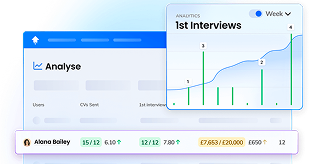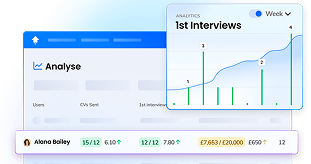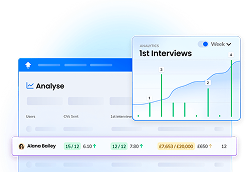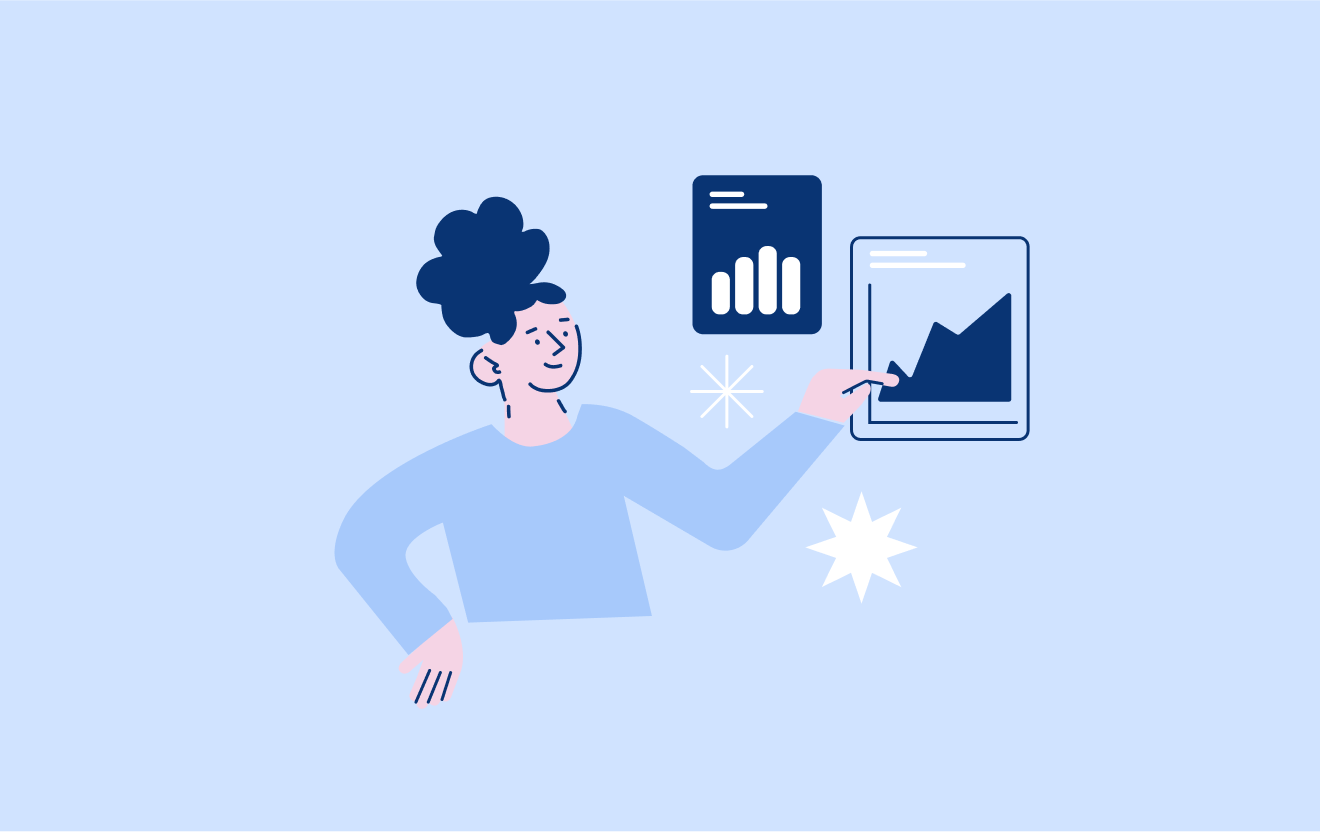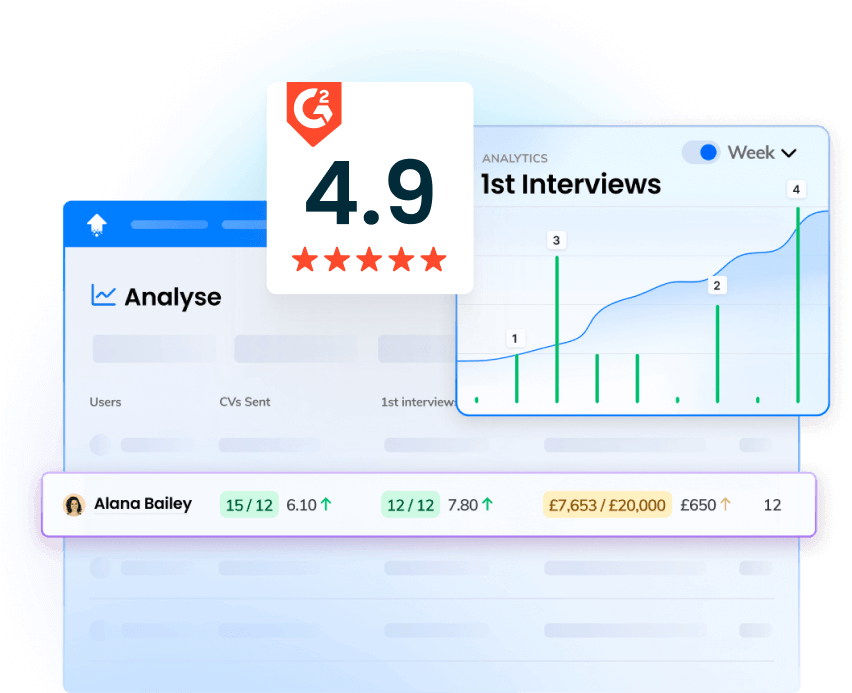Data analytics has been a game-changer for recruiters.
These tools give you crucial insights into how your recruiters, and your agency, is performing.
But did you know they can also give you an incredibly helpful look into how you’re likely to perform in future?
What will the recruitment market look like in my industry in three months?
How much revenue can my agency expect to generate this quarter?
Will this applicant be a great fit for this open role?
These are all questions data analytics can answer—with significantly more accuracy than the informed guesswork recruiters have relied on in the past.
When recruitment leaders have a good idea of how the future will look, they can make much smarter, data-driven decisions around their goals, strategy, candidates and clients.
This allows them to maximise upcoming opportunities and proactively prepare for challenging times.
Harness the power of data analytics, and you gain actionable insights that empower you to develop more data-driven, efficient, and competitive recruitment strategies.
Read on for everything you need to know about predicting future performance, from key use cases to steps to implementation.
What Does Predictive Performance Mean in Recruitment?
At its core, this is the practice of using past and present data to predict future outcomes.
Data analytics gives you key actionable insights into:
- Future revenue
- Seasonal demand for open jobs
- Hiring timeframes
- Candidate success and retention
- Recruiter performance
- Recruitment campaigns
- Hiring strategies
It helps recruiters identify ideal candidates, streamline hiring processes, and ultimately make more informed, data-driven decisions on a daily basis.
And in 2024, it's no secret that recruitment agencies must make data-driven decisions in order to survive.
But using this data to make key predictions takes this a step further, giving you an edge over your rivals in an increasing competitive recruitment landscape.
It supercharges these data-driven decisions, revealing not just the state of your agency today — but how it will look in a month, a quarter, or six months.
This empowers you to optimise your end-to-end recruitment process and solve problems before they even arise.
Key Use Cases of Data Analytics For Recruitment Performance Predictions
Where, specifically, can you put data analytics to work in your agency — and what tech do you need to make it work for you?
#1 Predicting Future Agency Revenue
Knowing how much revenue your agency is expected to generate this month, quarter, or year is incredibly useful.
First up, this helps you to plan your growth strategy, budgets, and gives you a vital look into your upcoming cash flow.
Your finance director will certainly thank you.
But if the numbers on your screen aren't what you were hoping to see, you still have time to dig deeper into the data to work out how to increase them.
You can use past hiring patterns, placements, and financial outcomes to forecast agency revenue.
Examine data such as the number of successful placements, client demand, candidate performance, and time-to-hire to identify trends and predict future hiring activity.
This allows agencies to estimate upcoming placements, client needs, and the resulting revenue.
Here's an example.
Let's say your recruitment agency focuses on healthcare staffing.
By analysing past data on job placements, client contracts, and candidate placements, you discover that placements in specialised nursing roles generate more revenue compared to general nursing positions.
You can then forecast future revenue by examining trends such as the frequency of these specialised roles and their average contract value.
For instance, if data shows that specialised nursing roles increase by 20% each year and generate an average of £7,500 per placement, the agency can predict a significant revenue boost in the upcoming year—if it focuses on these roles.
Furthermore, you can proactively target clients more likely to need specialised nurses, further boosting your revenue.
But in order to effectively use predictive analytics, you need to start by tracking your key metrics.
Recruitment analytics platform OneUp tracks key metrics such as revenue generated and Time-to-Hire that help agencies predict future revenue streams.

It pulls data from across your tech stack in real time to provide a single source of truth, with intuitive visualisations that make it easy to identify trends and bottlenecks.
#2 Forecasting Seasonal Demand for Open Jobs
In many industries, demand fluctuates from season to season.
This could be because there's more demand during summer, such as in hospitality, or around Christmas, like in retail.
Alternatively, demand for specific skills could spike due to a new game-changing development within the industry.
The emergence of generative AI, for example, has created many more roles within the tech industry.
To forecast seasonal demand, look at market trends and annual historical data to identify upcoming hiring peaks and troughs for various roles within the industries you hire into.
OneUp helps recruitment agencies prepare for seasonal spikes in hiring needs with intuitive visualisations that make it easy to understand historical data and create targets for the future.

With OneUp, you can see when your recruiters hired the highest volume of people for specific roles.
For example, suppose you're a recruitment agency that specialises in placing IT professionals.
Your data might reveal a seasonal surge in demand for software developers between October and December.
By identifying this pattern, you can forecast that, based on similar conditions, the agency is likely to place 15 developers during that period, generating £150,000 in revenue.
This helps the agency allocate resources, prepare candidates, and adjust marketing strategies to maximise profit during that busy period.
#3 Adjusting Activity Levels to Fill Positions Faster
Keen to reduce your time-to-hire?
Recruitment analytics can help.
Identify which recruitment activities to prioritise by analysing past hiring data, such as Time-to-Fill for various roles and sources of successful candidates.
Highlight the most effective channels, strategies, and recruitment stages that lead to quicker hires.
For instance, if data shows that candidates sourced through specific job boards are hired faster, the agency can focus more resources on those platforms, streamlining the recruitment process.
And when you know which roles are due to spike in demand, you can focus your sourcing efforts on proactively filling a talent pool with qualified candidates with the necessary skills.
To discover which recruitment activities are speeding up candidate placements and which are slowing you down, track key metrics using OneUp.
With OneUp, it's easy to drill down into the data behind the metrics to find out which activities are driving your successes and where the weak links in your processes lie.
#4 Forecasting Candidate Success and Retention
For recruitment agencies to maximise their commission, it's vital to place successful candidates who will stay in the role for the long term.
But for years, recruiters have only had application forms, CVs, and interviews—aka what the candidate tells us they can do—on which to base judgements.
At the same time, recruiters have been matching candidates to job descriptions based on what our clients think they need in an employee rather than what they actually need.
With data analytics, we can more accurately identify the candidates who would actually be the best fit for the role.
Analyse performance data from past hires, such as job performance reviews, tenure, and career progression, to identify key traits and behaviours linked to long-term success.
For example, your analysis might reveal that employees who consistently receive high scores in problem-solving and teamwork tend to stay with the company longer and advance in their careers.
You now know that including these soft skills in the job description is vital.
Next, assess new candidates for these traits during hiring.
This helps you deliver a superior service for clients — staffing them with employees who are more likely to thrive within and stay with the organisation — while also ensuring you secure your commission.
#5 Optimising Recruitment Campaigns
In many instances, recruitment campaigns are key to hiring success — but they can be costly, and they don't always return the results you're hoping for.
Tap into the power of data analysis, however, and you should see a lot more success.
By analysing past data, such as the performance of different job boards, social media platforms, and email campaigns, you can estimate which marketing channels and messaging will yield the best candidates for specific roles.
For instance, the data might show that candidates sourced through LinkedIn and industry-specific forums have a higher conversion rate and better job performance within your role compared to those from general job boards.
You can then allocate more budget and resources to the high-performing channels, optimise ad placements, and tailor messaging to attract the right talent.
This approach not only improves the efficiency of recruitment campaigns and cuts costs, but also enhances the quality of hires.
#6 Predicting Hiring Timeframes for Various Roles
Understanding how long it will take you to fill a position helps agencies set realistic client expectations.
And with OneUp, you can analyse past data in order to predict accurate timeframes.

For example, you may find it useful to know how long it will take to get from first interview to hire, or from CV sent to the first interview.
This increases transparency, allowing you to regularly update clients on expected timeframes, leading to enhanced client satisfaction and loyalty.
#7 Identifying High-Performing Recruiters
Performance-based recruiting is a highly effective way to drive your team to success.
Use OneUp's analytics to track recruiter performance via metrics such as their individual time-to-hire, quality of hire, CVs sent, interviews, cost per hire, and offer acceptance rate.

With OneUp's user-friendly interface, it's super easy to see which recruiters are on track to hit their goals and which are struggling.
By analysing these metrics, you can clearly identify your top performers and those in need of more support.
This allows you to:
- Accurately reward top performers
- Develop effective personal development plans
- Deliver targeted training to recruiters
- Pair top performers with lower-performing recruiters for training and mentoring
- Put top performers on your most valuable accounts
Benefits of Predicting Future Performance in Recruitment
Data analytics boost your hiring process from beginning to end — but what are some of the key benefits you can expect to see when using this tech to predict future performance?
#1 Faster Hiring and Reduced Time-to-Fill
Data insights allow agencies to focus on high-performing recruitment activities, slashing time-to-hire.
This means happier clients, happier candidates, and lower costs.
#2 Improved Candidate Matching
Armed with key data insights, you can identify candidates who are more likely to be a good fit for a role.
This data-driven technique leads to better-quality hires.
#3 Strategic Resource Allocation
When you have a good picture of what the future is going to look like, you can afford to be more strategic about your resource allocation.
Use data insights to allocate recruitment resources more effectively, prioritising roles that are likely to close faster.
#4 Data-Driven Decision-Making
Recruitment analytics empower agencies to make decisions based on accurate data.
Thankfully, the days of leading by gut instinct are over—now you have the information you need to improve efficiency confidently.
How to Leverage Data Analytics for Recruitment Predictions
In order to effectively leverage data analytics for recruitment predictions, there are a few key areas to consider.
#1 Setting Up Key Metrics and KPIs
If you're tracking irrelevant metrics, your data analytics tool won't give you the answers you want.
When choosing your key metrics and KPIs, you must first consider your agency's goals and challenges.
For example, if driving down spending is your main priority this year, you'll want to track metrics related to recruitment efficiency and costs.
On the other hand, if you're on a drive to boost your reputation, you'll want to focus on candidate and client satisfaction metrics, as well as retention.
With that said, here are some of the key metrics every agency should consider when looking to set up recruitment analytics:
- Time to hire: The average time it takes to fill a vacancy from posting to acceptance.
- Cost per hire: Total cost involved in the recruitment process, including advertising, recruitment agency fees, and internal resources.
- Quality of hire: Measurement of a new employee's performance, productivity, and retention over time.
- Source of hire: Analysis of which channels (job boards, referrals, social media, etc.) provide the best candidates.
- Candidate conversion rate: The percentage of candidates who proceed through various recruitment stages (e.g., from application to interview).
- Offer acceptance rate: Percentage of job offers that candidates accept.
- Employee retention rate: The percentage of new hires who stay with the company after a defined period (e.g., one year).
- Predictive fit score: A model-based score indicating how well a candidate is predicted to fit the role based on past data and patterns.
- Diversity metrics: Measurement of demographic data to ensure diverse hiring practices.
- Candidate satisfaction: Feedback from candidates regarding their experience during the recruitment process.
Of course, it would be costly and time-consuming to track all these metrics manually.
This is where recruitment analytics tools like OneUp come in.
OneUp helps you track and manage essential recruitment KPIs on user-friendly custom dashboards and automated reports.

Simply build a report once and automate it to land in your inbox whenever you need.
#2 Build Your Tech Stack
The software you choose will be central to whether your data analytics implementation is a success.
It's essential to look for recruitment software that has:
- User-friendly interface: Easy-to-navigate platform with minimal training required.
- Customisable dashboards and reports: Ability to tailor dashboards and reports to specific business needs.
- Advanced candidate matching: AI-driven tools that predict the best candidates for roles based on skill sets, experience, and cultural fit.
- Integration with existing systems: Seamless integration with CRMs
- Real-time analytics: Up-to-date data to make quick, informed decisions.
- Predictive hiring outcomes: Insights that forecast candidate performance, retention, and engagement levels.
- Bias detection and reduction: Features that identify and minimise unconscious bias in recruitment.
- Scalability: Capability to grow and adapt as the business expands or changes.
- Support and training: Comprehensive customer support and training resources for onboarding and long-term use.
OneUp delivers custom dashboards and reports based on real-time data that is automatically pulled from across your tech stack.
The Expected Results feature reveals which goals are on track to be hit and which are not.
Furthermore, OneUp boasts a super user-friendly interface with gamification features designed to engage and motivate users.
#3 Data Collection and Interpretation
Start by gathering high-quality, relevant data from various recruitment sources, such as CRMs, ATSs, candidate profiles, and employee performance records.
This data should cover previous years as well as more recent months — and it must be clean, consistent, and free from bias.
Data collection is not always easy, especially when you're going back years.
This typically means a multitude of tools and platforms, forgotten passwords, and knowledge gaps in the office.
Tools like OneUp come with a wide range of integrations that automatically pull data from across your tech stack, making this process much quicker and easier.
Once you've imported the data into your data analytics tool, set up the metrics and KPIs you want to track.
Build custom dashboards to track the trends that are important to you, and automate reports so you never miss a beat.
Then, when you need to make a prediction about your future performance, it’s easy to find the relevant data.
Steps to Implement Data Analytics for Recruitment Predictions
Ready to fire up the data analytics and enhance your agency’s future?
Here's how to start using predictive analytics for recruitment predictions in five steps.
Step 1: Data Assessment and Gathering
Perform a data audit to assess your existing data sources and identify any gaps.
Ensure the data is clean and consistent by removing duplicate or irrelevant information, fixing structural errors, filtering unwanted outliers or anomalies, and addressing missing data.
Step 2: Setting Clear Objectives for Analytics
Now your data is ready to go, it's time to define your SMART goals.
SMART goals are:
- Specific
- Measurable
- Achievable
- Relevant
- Time-bound
An example of a non-SMART goal might be:
"Increase candidate satisfaction in the coming year"
As a SMART goal, this would look more like:
"Boost candidate satisfaction by [X%] by [DATE]"
Once you've defined your SMART goals, select metrics that will help you track progress towards these goals and enable you to predict outcomes.
Step 3: Selecting the Right Tools
Choosing the right data analytics tools for your agency is key to success.
There are a wide variety of tools that help recruiters to track and analyse their data, empowering them to make informed predictions about future performance.
Some of this software may already be in your tech stack.
Types of recruitment analytics tools include:
- Recruiting Analytics Software: Platforms that track key metrics and help you to understand your data, such as OneUp.
- Applicant Tracking Systems (ATS): Tools that track candidates throughout their hiring journey.
- Resume screening tools: Automated tools that use algorithms to rank and filter resumes based on criteria.
- Predictive hiring assessments: Tests and questionnaires designed to predict a candidate's suitability for a role through behavioural and cognitive analysis.
- Workforce analytics software: Solutions that analyse workforce trends.
- Predictive sourcing platforms: Tools that identify the best channels and methods for sourcing high-quality candidates.
Step 4: Data Analysis and Insights
Next, import your data and chosen metrics into your chosen data analytics tools.
Set up custom dashboards and reports around your key metrics in order to identify patterns, such as factors influencing successful hires or employee retention.
Leverage these insights to predict future recruitment needs, improve candidate selection, reduce hiring time, and optimise overall recruitment strategies.
Step 5: Implementing and Monitoring Results
The point of implementing data analytics in recruitment is to make data-driven decision making a part of your team's daily workflow.
For example, if your candidate satisfaction level is forecast to be lower than expected, you might look at the activities contributing to that result and adjust them until a higher score is predicted.
Train your team to interpret insights from your analytics tools and incorporate them into decision-making in this way.
Remember to monitor the results you're seeing from your data analytics, too.
You may need to adjust your strategy if you're not experiencing a positive upswing in the metrics you're targeting.
Conclusion
Data-driven recruitment predictions are a key driver of more accurate, efficient, and competitive recruitment strategies.
But to make this work for your agency, first you need to access the right recruitment analysis tools.
OneUp empowers agencies by empowering recruitment leaders to track recruiter and team performance, and progress towards hiring goals.
This platform makes recruitment analytics easy and intuitive via user-friendly custom dashboards and automated reports with beautiful visualisations.

This allows agencies to optimise recruitment processes, minimise bias, and enhance overall hiring success, driving better outcomes and long-term strategic advantages.
Ready to tap into the game-changing power of data analytics?
Book a demo with OneUp today to find out how our platform could optimise your agency’s future.







